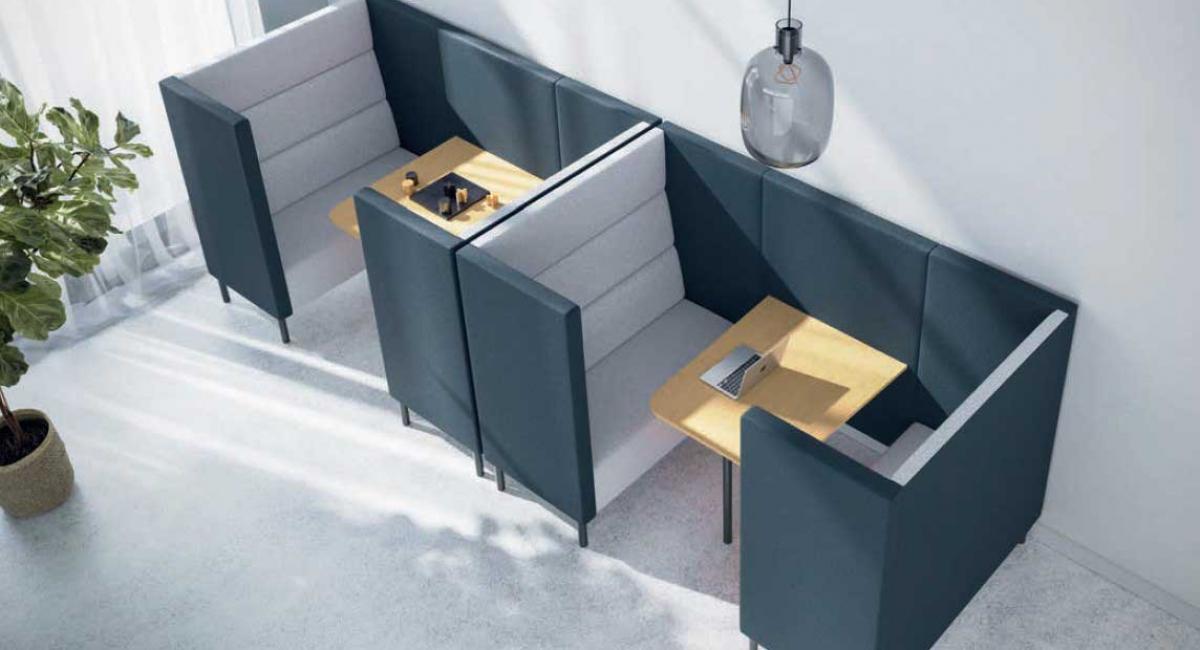


If you’re a business or organisation looking to balance sustainability with productivity a good place to start is analysing your office design and ensuring you are maximising your space.
Whether you’re a Procurement Manager looking to source quality office furniture or a Facility Manager looking to optimise the available square footage of your workspace, this blog is for you! We’ll guide you through some key strategies to make the most of your environment while enhancing employee wellbeing and reducing environmental impact.
One of the easiest ways to enhance your team’s wellbeing including productivity is to ensure you are using all the natural light resources available. Natural light has been shown to improve mood and productivity. This will in turn reduce the need for artificial lighting and help to reduce energy costs.
To fully maximise any natural light available, you could consider the placement of windows, glass doors and partitioning. These elements can help distribute light more evenly throughout the office. Additionally, using light-coloured walls and mirrors can further amplify the effect of natural light.
However, if your office lacks sufficient windows, skylights could be an alternative solution.
Flexible workspaces using adaptable office furniture have become increasingly popular in modern office design. Modular agile furniture can be easily reconfigured to meet changing needs of the business or organisation making it an ideal solution for dynamic work environments.
A key feature of flexible furniture is mobile furniture. Desks, chairs, storage, and tables on wheels allow for quick and easy rearrangement. Another important aspect of being flexible is making areas ‘multi-purpose.’ An example of this is a conference room. With the use of flexible furniture, you can effortlessly transform the area into a versatile space that could also be used for breakout or collaboration. This is a great way to make workspaces more efficient and cost-effective.
By introducing movable walls and partitions in large meeting rooms you can change the use of the area simply into smaller, more intimate spaces. This flexibility is ideal for accommodating several types of meetings, hosting events, or for general use.
Another good example of flexible furniture is multipurpose furniture, such as tables and chairs that can be folded and stored. These solutions will help maximise the use of meeting areas and enhance productivity.
The nation embraced hybrid and homeworking during the recent pandemic. So why change an efficient way to work? The components of remote working are key to space efficient office design and by granting employees the flexibility to work from home, companies can physically reduce the amount of office space needed. This not only reduces costs but also greatly reduces the environmental impact.
Further benefits of remote working include:
By introducing comfortable ergonomic furniture, you can fully maximise space efficiency.
Here are some examples of how ergonomic furniture can be introduced into your workspace:
When employees are comfortable, they are more likely to be productive, and so by investing in good ergonomic furniture, you can help improve employee well-being and productivity.
Open-plan layouts are one way to create collaborative spaces that encourage interaction and teamwork. However, it's important to balance openness with the need for privacy. By utilising partitions or modular furniture distinct zones can be created within your office layout.
Breakout areas and informal meeting spaces are also valuable for collaboration, these areas provide a relaxed environment where employees can brainstorm and share ideas.
While collaboration is important, employees also need quiet zones for focused work. These areas should minimise distractions, especially in open plan offices, and provide a tranquil environment for employees to be able to concentrate. Floor standing, wall mounted, ceiling suspended, hanging, or desktop acoustic panels and screens are all good solutions to help reduce noise levels in busy areas.
Soft furnishings, private or meeting pods, booths, and small enclosed rooms are ideal for focused work.
We all know how technology can enhance working environments, but it can also take an effective role in space-efficient design.
Everything from smart lighting systems to climate control, technology can help optimise the use of space and resources. A further example of advanced technology includes wireless charging stations, printers and scanners ensuring no bulky cords and cables and offering greater flexibility as they can be placed anywhere in the office.
To create a more relaxing and pleasant environment, plants and green spaces can be a valuable addition to efficient office design. Plants not only improve air quality but also create a more relaxing and pleasant environment for your employees, clients, and visitors.
Incorporating a green space can be as simple as adding potted plants to desks and shelves, or for more a striking effect, you could consider installing a living wall. These features can serve as focal points and enhance the overall aesthetic of the office.
Space-efficient office design is a powerful tool for enhancing productivity, sustainability, and employee well-being. By leveraging natural light, flexible workspaces, remote work options, and ergonomic furniture, businesses can create dynamic and adaptable work environments.
Ready to transform your office? We’re here to help! We can assist you in evaluating your current space and help you implement these space-efficient design principles in your workspace to enhance your team’s working environment and improve motivation and productivity.
Tags: Office Furniture, Sustainability, Space Design, Project Management, Office Interiors, Ergonomic Office Furniture, Acoustic Screens, Flexible Furniture, Agile Furniture, Hybrid Furniture





Cambridgeshire
Unit 6-8 Centree House
River Road
Bicton Industrial Park
Kimbolton
Cambridgeshire
PE28 0LQ
Suffolk
Suite 3.11, Felaw Maltings
44 Felaw Street
Ipswich
Suffolk
IP2 8SJ
